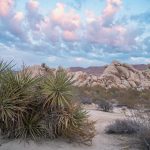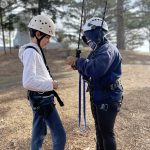Sean Altman is the Bay Area Program Director at Outward Bound California. He’s also a food lover and spends a lot of his personal time cooking with, and for, friends; he considers himself a master barbecue and taco man. He has a lot to share and his love for backcountry baking is inspiring. In this interview, he talks about his backcountry cooking experience and shares his favorite backcountry baking recipe and techniques.
How do you plan for food in the backcountry?
I like to plan food for personal trips in a “pantry style” rather than a meal plan. It gives me a little more freedom to change it up.
What was your first experience with cooking in the backcountry?
It was macaroni and cheese from scratch. It ended up being a globby mess that just tasted awful. The macaroni got burnt and it didn’t taste that good. We didn’t quite understand just how hot a whisper lite (stove) got. We were baffled that we couldn’t get it to simmer. Our ambitions were high and we overshot! A lot of learning from that trip for sure.
How has that first experience influenced how you plan food in the backcountry?
I’d say I pay attention to details now. Like planning ahead and understanding your equipment. The whisper lite is a standard backcountry cooking stove. I have expanded outside of this stove to have the freedom to go hotter or simmer. All of this took a lot of time and a lot of trial and error.
Would you encourage folks to trial by error with their backcountry food?
Yes, but if you choose to go this route, do it on a 3-night trip. If you mess something up on a 10-day trip or longer, you’ll be really hosed. I also suggest, if you have a planned car camping trip, go outside the box and bring your camping stove. And test these recipes at home. Just in case you need to go out and grab a burrito.
What are your 2 favorite backcountry recipes?
Four cheese mac and cheese. THE MAC ATTACK is my go-to meal for the first night of the backcountry.
Cinnamon rolls. This goes above and beyond. It’s a 12-hour process so you are planning for them before you leave. Backcountry bread is definitely a thing. It scares a lot of people and it shouldn’t. It’s basic chemistry and microbiology. If you put the attention and effort into preparing you can really “up everyone’s game” by busting these out.
Sean reminds us that food is the most basic form of satisfaction; eating and feeling sustained is primal. He reiterates the first meal of any backcountry trip as the most important and can set a tone. He also reminds us of the power of a good meal, it can change the morale of an entire group. Something any trip leader knows is key to the success of any adventure.
Backcountry Cinnamon Rolls
Pre-weigh out flour
½ lb white all purpose flour
½ lb of whole wheat flour
1 package active dry yeast
Salt
1 stick of butter
Cinnamon
Brown sugar
Materials: Nalgene bottle, gallon zip lock bag (2), heavy duty ice bag (1), floss (non-mint), stove, Fry-bake, Diffuser plate, and Pot Parka
Heat a bit of water in a separate dish to 100-105 degrees Fahrenheit.
Add the package of yeast into the water. Add a pinch of brown sugar. Mix the warm water, yeast, and sugar into a small dish and let the yeast foam.
Add this water to the flour mixture along with 3 tablespoons of brown sugar into a container, open ice bags are especially good for this. A pinch of salt, a 1 oz. Nalgene container cap is about a tablespoon. Mix directly into the bag. Add a tablespoon at a time of warm water to the mix and make a dough ball at the bottom of the bag.
Remove all the air from the bag and tie a loose knot on the top.
Next is the “dough baby”. Place the bag of dough under your shirt next to your skin. You want to tuck your shirt in so that the dough baby stays in place and you are going to sleep with the dough close to you. The reason for the loose knot is because the yeast is going to release C02 and rise. The bag is going to expand. Throughout the night you will have to burp the dough baby by releasing the CO2 and then retying the loose knot.
In the morning you will have a fully risen ball of dough.
With some butter, grease the entire inside of the fry-bake. Place this on top of a diffuser plate and then you light a “twiggy-fire”, a small fire made of twigs on top of the fry-bake. This creates the heat on top which simulates your backcountry oven. If you are in an area where you can not make a fire you can also bring what’s called a pot-parka. This acts as bonnet over your pot to create an oven atmosphere.
Roll your dough out onto a split gallon zip lock bag onto a table or insulated pad to act as a clean surface. Roll it into a square. Sean uses a Nalgene bottle that is wrapped in another plastic bag. The dough should be smooth.
From there you are going to spread brown sugar all over the dough. Then sprinkle it with cinnamon and evenly distribute small chunks of butter. Then, start from one end and roll in into a spiral; pinch closed the seam so there is one nice smooth spiral. Then cut the spiral into 1 in pieces with a piece of floss by putting the floss underneath, then cross it on the top, it will cut evenly from all directions.










